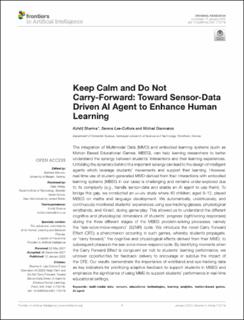| dc.description.abstract | The integration of Multimodal Data (MMD) and embodied learning systems (such as Motion Based Educational Games, MBEG), can help learning researchers to better understand the synergy between students' interactions and their learning experiences. Unfolding the dynamics behind this important synergy can lead to the design of intelligent agents which leverage students' movements and support their learning. However, real-time use of student-generated MMD derived from their interactions with embodied learning systems (MBEG in our case) is challenging and remains under-explored due to its complexity (e.g., handle sensor-data and enable an AI agent to use them). To bridge this gap, we conducted an in-situ study where 40 children, aged 9–12, played MBEG on maths and language development. We automatically, unobtrusively, and continuously monitored students' experiences using eye-tracking glasses, physiological wristbands, and Kinect, during game-play. This allowed us to understand the different cognitive and physiological dimensions of students' progress (right/wrong responses) during the three different stages of the MBEG problem-solving processes, namely the “see-solve-move-respond” (S2MR) cycle. We introduce the novel Carry Forward Effect (CFE); a phenomenon occurring in such games, whereby students propagate, or “carry forward,” the cognitive and physiological effects derived from their MMD, to subsequent phases in the see-solve-move-respond cycle. By identifying moments when the Carry Forward Effect is congruent (or not) to students' learning performance, we uncover opportunities for feedback delivery to encourage or subdue the impact of the CFE. Our results demonstrate the importance of wristband and eye-tracking data as key indicators for prioritizing adaptive feedback to support students in MBEG and emphasize the significance of using MMD to support students' performance in real-time educational settings. | en_US |

